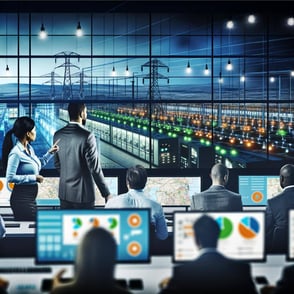Virtual Power Plants/Aggregators
Virtual Power Plants (VPPs) aggregate and optimize decentralized energy resources like solar and wind to function as a single power plant, enhancing grid reliability and integrating renewables.
What are Virtual Power Plants?
Virtual Power Plants (VPPs) also known as aggregators, represent a transformative approach in the energy sector, optimizing the combined output of distributed energy resources (DERs) such as wind turbines, solar panels, and small natural gas generators to supply electricity just as traditional power plants do. VPPs utilize sophisticated software and a smart grid to remotely and automatically dispatch and optimize generation, storage, or load across an interconnected network. These systems can aggregate power from disparate sources, enhancing grid reliability and enabling the integration of renewable energy sources.
Virtual Power Plants are advanced software systems that combine various decentralized energy resources to function as a single power plant. Unlike traditional power plants that rely on large-scale, centralized generation facilities, VPPs leverage existing distributed systems to produce energy, which can be sold on the electricity market or used to balance the grid. By intelligently managing the production and distribution of electricity from multiple small-scale sources, VPPs can effectively match energy supply with demand and respond dynamically to changing market conditions.
How Virtual Power Plants Work
The operation of an aggregator involves several key processes: aggregation, optimization, dispatch, and management. Initially, the VPP aggregates available capacities from various DERs connected across the network. This pooled capacity is then optimized using algorithms that predict local energy demands and calculate the most efficient way to distribute resources to meet these needs.
The dispatch process in VPPs is dynamic, allowing for real-time response to grid demands. For example, during peak load times, a VPP can instantaneously command stored energy to be released into the grid or reduce consumption at certain sites to balance the load without resorting to traditional grid solutions. Management of these processes is continuous and data-driven, ensuring optimal performance and grid stability. This includes the analysis of energy production and usage data, forecasting demand, and making adjustments as necessary to maintain balance and efficiency.
The Impact of Virtual Power Plants on the Energy Sector
Virtual Power Plants significantly influence the energy sector by enhancing grid reliability and integrating renewable energy sources more effectively. These systems facilitate a shift from centralized to decentralized energy production, reducing reliance on large-scale power plants and promoting local, sustainable energy generation. This decentralization helps mitigate the variability issues often associated with renewable energy sources, such as solar and wind, by providing a mechanism to balance supply with demand across a broad network.
Moreover, VPPs contribute to the economic efficiency of power markets. They optimize the use of existing infrastructure, which can defer or eliminate the need for new power plants and transmission lines. They also provide financial benefits to participants of the VPP by enabling them to sell back excess power to the grid at peak prices or reduce costs by lowering peak demand charges.
Conclusion
Virtual Power Plants represent a forward-thinking solution to the challenges of modern energy management and grid stability. By efficiently coordinating distributed energy resources, VPPs not only enhance the reliability of the power grid but also drive the adoption of renewable energy technologies. As the energy landscape continues to evolve towards greater sustainability and resilience, the role of VPPs will become increasingly central in shaping a robust, efficient, and flexible energy infrastructure.
Glossary
- Virtual Power Plant (VPP): A system that integrates various distributed energy resources to function collectively as a single power plant.
- Distributed Energy Resources (DERs): Small-scale electricity supply or demand resources that are connected to the grid at distribution level.
- Aggregation: The process by which individual small-scale generation units are combined to act as a single larger entity.
- Optimization: The application of strategic calculations to maximize efficiency in the distribution and usage of resources.
- Dispatch: The process of controlling and directing the output of electricity generation resources to meet the demand in real-time.
- Real-time Data: Information provided immediately after collection, enabling timely decision-making and operations.
.png?width=200&height=80&name=etpa-logo-color%20(1).png)



.png)
.png)
-1.png?width=250&height=100&name=etpa-logo-color%20(1)-1.png)